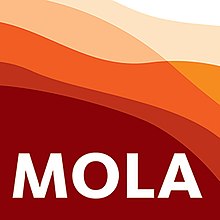
Dame Kathleen Mary Kenyon, was a British archaeologist of Neolithic culture in the Fertile Crescent. She led excavations of Tell es-Sultan, the site of ancient Jericho, from 1952 to 1958, and has been called one of the most influential archaeologists of the 20th century. She was Principal of St Hugh's College, Oxford, from 1962 to 1973, having undertaken her own studies at Somerville College, Oxford.

Southwark is a district of Central London situated on the south bank of the River Thames, forming the north-western part of the wider modern London Borough of Southwark. The district, which is the oldest part of South London, developed due to its position at the southern end of the early versions of London Bridge, for centuries the only dry crossing on the river. Around 43 AD, engineers of the Roman Empire found the geographic features of the south bank here suitable for the placement and construction of the first bridge.
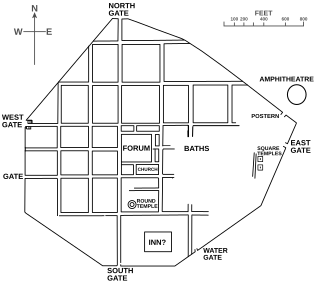
Calleva Atrebatum was an Iron Age oppidum, the capital of the Atrebates tribe. It then became a walled town in the Roman province of Britannia, at a major crossroads of the roads of southern Britain.
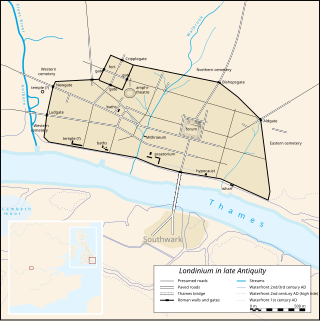
Londinium, also known as Roman London, was the capital of Roman Britain during most of the period of Roman rule. Most twenty-first century historians think that it was originally a settlement established shortly after the Claudian invasion of Britain, on the current site of the City of London around 47–50 AD, but some defend an older view that the city originated in a defensive enclosure constructed during the Claudian invasion in 43 AD. Its earliest securely-dated structure is a timber drain of 47 AD. It sat at a key ford at the River Thames which turned the city into a road nexus and major port, serving as a major commercial centre in Roman Britain until its abandonment during the 5th century.
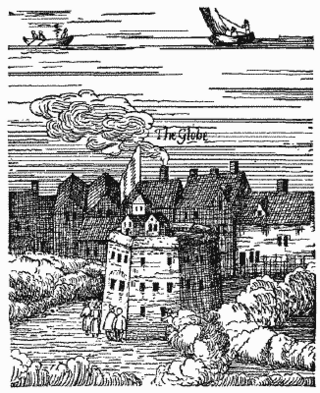
The Rose was an Elizabethan theatre. It was the fourth of the public theatres to be built, after The Theatre (1576), the Curtain (1577), and the theatre at Newington Butts – and the first of several playhouses to be situated in Bankside, Southwark, in a liberty outside the jurisdiction of the City of London's civic authorities. Its remains were excavated by archaeologists in 1989 and are listed by Historic England as a Scheduled Monument.

The London Wall is a defensive wall first built by the Romans around the strategically important port town of Londinium in c. AD 200, as well as the name of a modern street in the City of London, England.

Aldwych is a street and the name of the area immediately surrounding it, in the City of Westminster, part of Greater London, and is part of the West End Theatreland. The 450 metres (1,480 ft) street starts 600 metres (2,000 ft) east-northeast of Charing Cross, the conventional map centre-point of the capital city.
The Prittlewell royal Anglo-Saxon burial or Prittlewell princely burial is a high-status Anglo-Saxon burial mound which was excavated at Prittlewell, north of Southend-on-Sea, in the English county of Essex.
The Lorteburn or Langbourne is a lost stream or river, which ran in the east of the City of London, arising near to Aldgate, flowing south near to the Tower of London, and discharging into the River Thames. The stream appears to have been covered over or dry by the early 14th century but its course has been discovered during archaeological digs in the area and the watershed can be traced in the street level contours of that part of the city as mapped by Kelsey in 1841. The stream gave its name to the Langbourn ward of the city. The river is seldom included on maps or lists of London's lost rivers, and its existence is denied by Nicholas Barton, in his 1962 book Lost Rivers of London, but in more recent work David Bentley argues for its existence.

The Petrie Museum of Egyptian Archaeology in London is part of University College London Museums and Collections. The museum contains 80,000 objects, making it one of the world's largest collections of Egyptian and Sudanese material. It is designated under the Arts Council England Designation Scheme as being of "national and international importance".
Oxford Archaeology is one of the largest and longest-established independent archaeology and heritage practices in Europe, operating from three permanent offices in Oxford, Lancaster and Cambridge, and working across the UK. OA is a Registered Organisation with the Chartered Institute for Archaeologists (CIfA), and carries out commercial archaeological fieldwork in advance of development, as well as a range of other heritage related services. Oxford Archaeology primarily operates in the UK, but has also carried out contracts around the world, including Sudan, Qatar, Central Asia, China and the Caribbean. Numbers of employees vary owing to the project-based nature of the work, but in 2023 OA employed over 350 people.

The history of Anglo-Saxon London relates to the history of the city of London during the Anglo-Saxon period, in the 7th to 11th centuries.

The New Churchyard was a municipal and non-parochial burial ground in London. Established in 1569, it was used for burial from 1570 until 1739, by which date approximately 25,000 interments were estimated to have taken place. It was created to accommodate the ever-increasing number of new interments required as London's population expanded during 16th to 18th centuries. It was known as a "churchyard" despite not being associated with a church and, from the mid-17th century, became more commonly known as Bedlam or Bethlem burial ground because its location within the "Bedlam" or "Bethlem" area. The remains of the burial ground are now located under modern Liverpool Street, within the north-east corner of the City of London.
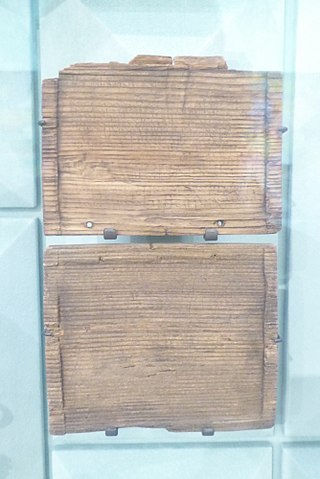
The Bloomberg tablets are a collection of 405 preserved wooden tablets that were found at the site of the Bloomberg building in the financial district of London. Excavations of the site took place between 2010 and 2013, after which the current Bloomberg building was constructed on the site of the archaeological dig.
Britain at Low Tide is an archaeology and social history television programme that debuted on Channel 4 in 2016, with further series in 2018 and 2019. It was originally co-hosted by former Time Team and Victorian Farm contributor, archaeologist and historian Dr. Alex Langlands and Natural History Museum palaeobiologist Dr. Tori Herridge.
Coastal and Intertidal Zone Archaeological Network, known by its abbreviation CITiZAN, is a community archaeology project working in areas of England's coastline documenting coastal and intertidal history before it is washed away by tidal forces.
Gustav Milne is a British Archaeologist, writer and TV contributor who is the current project lead for Coastal and Intertidal Zone Archaeological Network (CITiZAN) and Honorary Senior Lecturer at the UCL Institute of Archaeology.
Kenneth Andrew Rodney Westman is an English archaeologist and head of projects at the Museum of London. He is perhaps best known for contributing to, and editing, Archaeology in the City of London, 1907–91: a Guide to the Records of Excavations and writing the Archaeological Site Manual in 1994.
The Great Dover Street woman is the skeleton of a Romano-British woman discovered in excavations at 165 Great Dover Street, Southwark, London. She is suggested to have been a female gladiator, though this interpretation is contested.
The Harpole Treasure is a collection of Anglo-Saxon artefacts excavated at a bed burial discovered in spring 2022 in Harpole, Northamptonshire, England. It includes a necklace described as "the most ornate of its kind ever found". The Anglo-Saxon site dates to between 630 and 670 CE. The woman buried at the site is presumed to have been of high status in the early Christian church. The archaeological site is classified as a bed burial, in which the person, typically a woman of high status, was interred on top of a bed.
